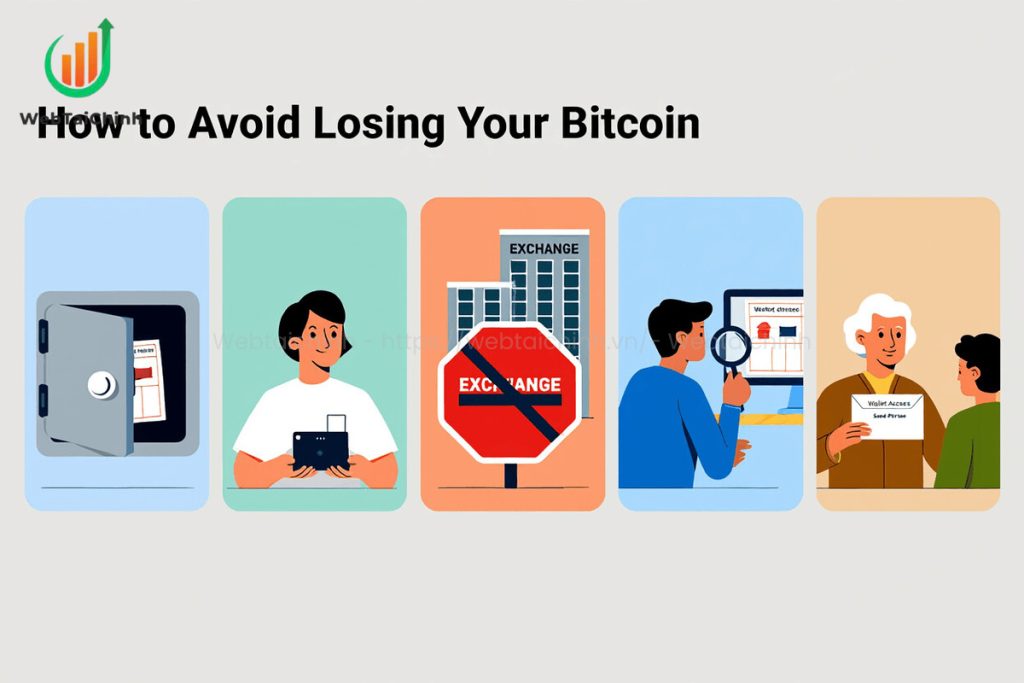Physical Address
304 North Cardinal St.
Dorchester Center, MA 02124
Physical Address
304 North Cardinal St.
Dorchester Center, MA 02124

Bitcoin’s fixed supply of 21 million coins makes it unique among assets, but not all those coins are actually available. In fact, a significant portion may be lost forever due to forgotten private keys, destroyed hardware, or simple human error.
So, how many Bitcoin are lost permanently, and what does that mean for the future of cryptocurrency? In this article, Vietnam-ustrade will dive deep into the statistics, reasons, and consequences of lost BTC, and share practical tips to safeguard your digital assets.
Before exploring the numbers, it’s crucial to define what lost means in the context of Bitcoin. Unlike physical cash, Bitcoin doesn’t disappear from the blockchain. Instead, it becomes inaccessible when the user loses control over the associated wallet.
When someone forgets their private key, misplaces their seed phrase, or passes away without sharing access is gone forever – similar in effect to forced selling or what does liquidation mean in crypto, though with different causes., the Bitcoin remains on the blockchain, but it’s functionally gone. There’s no central authority to reset the password, and no way to reclaim coins from an abandoned address without the key.

It’s similar to losing cash, but with a major difference: nobody can pick up your lost Bitcoin and spend it. If no one can sign a transaction from the wallet, the coins are effectively locked away forever.
Importantly, we must distinguish between:
This concept affects how we interpret the total Bitcoin circulating supply versus lost coins. That’s why a growing number of people are now asking how many bitcoin are lost, and how it impacts Bitcoin’s true scarcity a topic we’ll explore in the next section.
Estimates suggest that between 3 to 4 million Bitcoin may have been lost forever, representing 15–20% of all BTC mined. However, the exact number varies depending on the methodology used.
These discrepancies arise from differing definitions of lost. Some reports include Satoshi Nakamoto’s untouched stash (~1 million BTC), while others exclude them due to the speculative nature of their status.

Blockchain does not record intent or ownership, only transactions, so we rely on behavioral clues. Long-term inactivity, lack of movement, and known loss incidents form the basis of these analyses.
Interestingly, some dormant wallets have recently become active again, challenging assumptions. This dormant-to-active wallet trend suggests we must treat loss estimates as dynamic, not fixed.
Still, the consensus is clear: millions of Bitcoin are likely lost forever, contributing to the scarcity narrative.
Losing access to Bitcoin is not a rare mishap, it’s a systemic vulnerability in the crypto ecosystem. Unlike fiat currencies, Bitcoin holders are entirely responsible for safeguarding their assets.
When access credentials are lost or storage devices fail, the coins become unspendable, effectively vanishing from circulation.
The decentralized nature of Bitcoin means there’s no central authority to turn to for help. This design strengthens its security, but it also exposes users to a harsh reality: there’s no safety net.
As the popularity of crypto grew, so did the number of unprepared or careless holders, leading to millions of BTC being permanently lost. While exact figures are debated, estimates vary widely when trying to determine how many bitcoin are lost with some analyses suggesting up to 20% of all mined coins.

Let’s explore the four most common causes behind lost Bitcoin. Each one reveals an important lesson in personal responsibility and crypto asset management.
The number one reason Bitcoin gets lost is the loss of private keys or seed phrases, the only way to unlock access to a Bitcoin wallet. If either is forgotten, misplaced, or never recorded properly, the coins inside the wallet become permanently inaccessible.
Early Bitcoin adopters often underestimated the long-term value of BTC. Many treated it like experimental tech, jotting down keys on scrap paper or saving files on unprotected computers. Years later, as BTC value soared, they realized they had no way to retrieve it.
Unlike centralized banks or platforms with recovery options, Bitcoin wallets have zero account recovery features. If you lose your key, there is no “forgot password” function. This also means that accidental loss is final and irreversible.
Real example: A developer lost access to 7,000+ BTC stored on an old wallet.dat file because he forgot the decryption passphrase, worth over $200 million at today’s prices.
This scenario highlights how powerful, and dangerous, Bitcoin self-custody can be without careful preparation.
Another major culprit is the loss or physical destruction of devices used to store Bitcoin wallets. Whether it’s an old laptop, a mobile phone, or an external hard drive, these devices can easily be misplaced, stolen, or damaged beyond repair.
When Bitcoin wallets are stored locally without backups, any incident, fire, flood, theft, formatting, can render the coins inaccessible. Even encrypted backups can become useless if the password is lost along with the device.
Real example: In 2013, James Howells accidentally threw away a hard drive containing 7,500 BTC while cleaning out his home. He’s spent years petitioning authorities to let him excavate the landfill where it might still be buried. Cases like this raise the question of how many bitcoin are lost due to accidental hardware disposal and how much of Bitcoin’s supply is permanently inaccessible.

The lesson here is clear: relying on a single physical point of failure without redundancy can lead to catastrophic financial consequences. Secure backups, offsite storage, and redundancy are essential in crypto asset management.
Bitcoin’s immutability is a double-edged sword. While it ensures trust and transparency, it also means that any mistake in transaction execution is permanent. Sending BTC to a wrong address, whether by typo, misunderstanding, or copy-paste error, can result in irreversible loss.
Some blockchain addresses are valid in structure but have no actual private key owner. Sending coins to such an address is equivalent to burning them.
Additionally, smart contract errors or format mishandling can lead to coins being trapped in unspendable conditions, especially in tokens or altcoins built on Ethereum, but occasionally in BTC too.
Real example: Over 2,600 BTC were sent to a nonstandard address in 2010 that had no known private key, worth over $170 million today. The mistake was technical but fatal.
The mistake was technical but fatal. Cases like this continue to raise the question of how many bitcoin are lost due to human error a reminder that even small oversights can have irreversible consequences.
These incidents underline the need for rigorous transaction hygiene, always verifying recipient addresses, testing with small transfers first, and double-checking wallet compatibility before moving large sums.
One of the least discussed yet most tragic causes of Bitcoin loss is death without a crypto inheritance plan. When a BTC holder dies without sharing wallet access with heirs, or at least leaving secure instructions, their holdings become inaccessible forever.
This is particularly concerning in the crypto space, where no legal or institutional mechanisms exist to transfer ownership automatically. Traditional estate planning tools often don’t include provisions for digital assets.
Real example: A Canadian crypto exchange founder passed away in 2018, reportedly being the only one with access to the exchange’s wallets. Over 26,000 BTC were locked, affecting thousands of customers. Stories like this add to the uncertainty around how many bitcoin are lost due to poor inheritance planning an often overlooked but growing issue in the crypto space.
Crypto inheritance requires intentional planning, writing down seed phrases, choosing a trustworthy successor, and possibly using smart contract-based solutions or legal custodians to facilitate access after death.
Failing to plan for the unexpected can undo a lifetime of disciplined investing.
In most cases, lost Bitcoin is permanently inaccessible. There is no centralized recovery service, no customer support, and no magic reset button on the blockchain.

However, rare recoveries do happen, under specific circumstances:
Still, only about 2.5% of lost coins are deemed recoverable, according to Chainalysis.
Be cautious: many so-called recovery services are scams or deliver malware. Always verify credentials and avoid handing over sensitive information to untrusted sources.
In short, the odds are against recovery, making prevention the best defense.
Lost Bitcoin affects more than just the owners. It impacts the entire ecosystem:
Despite millions of BTC being inaccessible, the Bitcoin network continues functioning normally. But just how many bitcoin are lost, and what does that number mean for scarcity, value, and long-term adoption?
However, when old wallets suddenly wake up, it can cause market speculation or fear, especially if they’re linked to early miners or whale addresses.
Still, from a security standpoint, these events don’t harm the integrity of the blockchain.
To protect your Bitcoin from becoming another lost statistic and to avoid contributing to the growing number of how many bitcoin are lost follow this checklist of best practices:
To protect your Bitcoin from becoming another lost statistic, follow this checklist of best practices:

Each step reinforces a core truth: self-custody requires responsibility.
Pro tip: Consider using multisig wallets or trusted guardianship services for added resilience.
Continue learning with these articles:
Estimates vary, but most studies suggest between 3–4 million BTC are permanently inaccessible.
Rarely. Only if partial access data (e.g., seed fragments, wallet files) is available. Most are gone forever.
Technically not lost, just untouched. But many analysts include Satoshi’s ~1 million BTC in effectively lost stats.
It reduces the circulating supply, making remaining BTC scarcer, potentially increasing long-term value.
Yes. Secure storage, backups, hardware wallets, and inheritance planning are essential.
How many bitcoin are lost? An estimated 3-4 million Bitcoin are lost forever, an eye-opening reality with implications beyond individual users. These missing coins serve as a cautionary tale and a crucial reminder that security and self-responsibility are foundational to crypto ownership.
We urge every investor to take proactive steps to protect their assets. Remember:
Web Tai Chinh is a portal that updates news and information related to finance quickly and accurately, helping users have an overview before investing, clearly understanding concepts and terms related to Finance. Explore more insights in our Cryptocurrency category, start your crypto wallet development journey today with the right partner for long-term success.
📞 Contact: 055 937 9204
✉️ Email: webtaichinhvnvn@gmail.com
📍 Address: 13 Ho Tung Mau, An Binh, Di An, Binh Duong